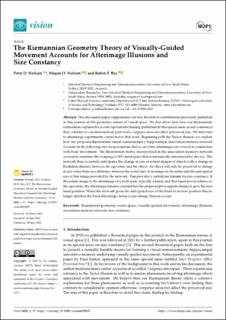| dc.contributor.author | Neilson, Peter D. | |
| dc.contributor.author | Neilson, Megan D. | |
| dc.contributor.author | Bye, Robin Trulssen | |
| dc.date.accessioned | 2023-03-03T09:17:20Z | |
| dc.date.available | 2023-03-03T09:17:20Z | |
| dc.date.created | 2022-09-23T13:46:28Z | |
| dc.date.issued | 2022 | |
| dc.identifier.citation | Vision. 2022, 6 (2), . | en_US |
| dc.identifier.issn | 2411-5150 | |
| dc.identifier.uri | https://hdl.handle.net/11250/3055648 | |
| dc.description.abstract | This discussion paper supplements our two theoretical contributions previously published in this journal on the geometric nature of visual space. We first show here how our Riemannian formulation explains the recent experimental finding (published in this special issue on size constancy) that, contrary to conclusions from past work, vergence does not affect perceived size. We then turn to afterimage experiments connected to that work. Beginning with the Taylor illusion, we explore how our proposed Riemannian visual–somatosensory–hippocampal association memory network accounts in the following way for perceptions that occur when afterimages are viewed in conjunction with body movement. The Riemannian metric incorporated in the association memory network accurately emulates the warping of 3D visual space that is intrinsically introduced by the eye. The network thus accurately anticipates the change in size of retinal images of objects with a change in Euclidean distance between the egocentre and the object. An object will only be perceived to change in size when there is a difference between the actual size of its image on the retina and the anticipated size of that image provided by the network. This provides a central mechanism for size constancy. If the retinal image is the afterimage of a body part, typically a hand, and that hand moves relative to the egocentre, the afterimage remains constant but the proprioceptive signals change to give the new hand position. When the network gives the anticipated size of the hand at its new position this no longer matches the fixed afterimage, hence a size-change illusion occurs. | en_US |
| dc.language.iso | eng | en_US |
| dc.publisher | MDPI | en_US |
| dc.rights | Navngivelse 4.0 Internasjonal | * |
| dc.rights.uri | http://creativecommons.org/licenses/by/4.0/deed.no | * |
| dc.title | The Riemannian Geometry Theory of Visually-Guided Movement Accounts for Afterimage Illusions and Size Constancy | en_US |
| dc.title.alternative | The Riemannian Geometry Theory of Visually-Guided Movement Accounts for Afterimage Illusions and Size Constancy | en_US |
| dc.type | Peer reviewed | en_US |
| dc.type | Journal article | en_US |
| dc.description.version | publishedVersion | en_US |
| dc.source.pagenumber | 0 | en_US |
| dc.source.volume | 6 | en_US |
| dc.source.journal | Vision | en_US |
| dc.source.issue | 2 | en_US |
| dc.identifier.doi | 10.3390/vision6020037 | |
| dc.identifier.cristin | 2054852 | |
| cristin.ispublished | true | |
| cristin.fulltext | original | |
| cristin.qualitycode | 1 | |

